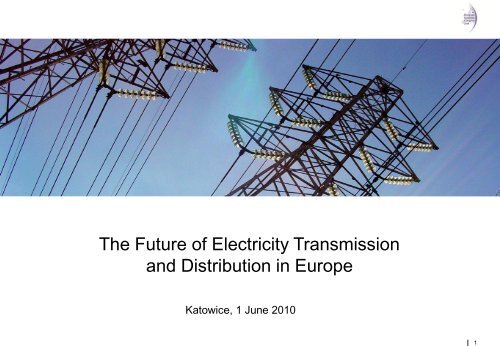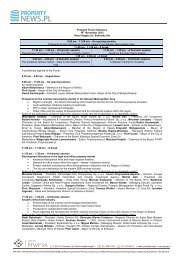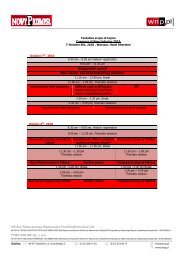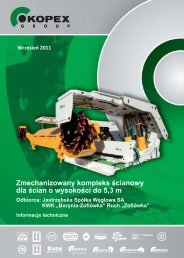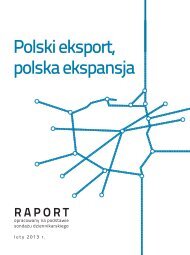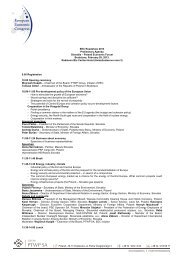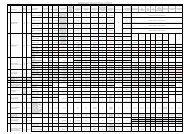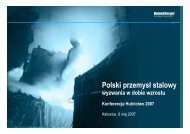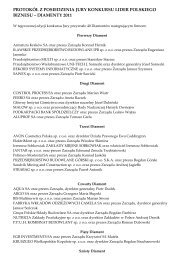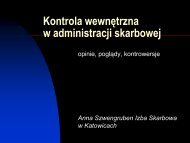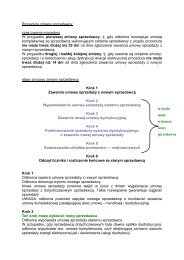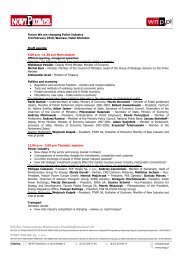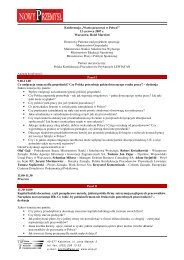The Future of Electricity Transmission and Distribution in ... - p.wnp.pl
The Future of Electricity Transmission and Distribution in ... - p.wnp.pl
The Future of Electricity Transmission and Distribution in ... - p.wnp.pl
You also want an ePaper? Increase the reach of your titles
YUMPU automatically turns print PDFs into web optimized ePapers that Google loves.
<strong>The</strong> <strong>Future</strong> <strong>of</strong> <strong>Electricity</strong> <strong>Transmission</strong><br />
<strong>and</strong> <strong>Distribution</strong> <strong>in</strong> Europe<br />
Katowice, 1 June 2010<br />
1
Meet<strong>in</strong>g agenda (duration <strong>in</strong> m<strong>in</strong>utes)<br />
Organizational matters / <strong>in</strong>troduction <strong>of</strong> participants 5<br />
Introduction presentation 15<br />
Panel discussion – topic no. 1 – Regulatory systems 25<br />
Conclusion – topic no. 1 5<br />
Panel discussion – topic no. 2 – New technologies 25<br />
Conclusion – topic no. 2 5<br />
LitGrid presentation 10<br />
Panel discussion – topic no. 3 – Bus<strong>in</strong>ess models 25<br />
Conclusion – topic no. 3 5<br />
Total 120<br />
2
MACRO APPROACH<br />
<strong>Transmission</strong> <strong>and</strong> <strong>Distribution</strong> <strong>of</strong> electricity <strong>pl</strong>ay a major role <strong>in</strong> the<br />
energy security cha<strong>in</strong><br />
Energy system security cha<strong>in</strong><br />
Responsible<br />
entities<br />
Element <strong>of</strong><br />
the security<br />
cha<strong>in</strong><br />
Key security<br />
drivers<br />
MINING OF ENERGY<br />
RESOURCES<br />
• Stable sources <strong>of</strong><br />
raw material<br />
procurement<br />
State adm<strong>in</strong>istration (Regulator, M<strong>in</strong>istry <strong>of</strong> Economy)<br />
GENERATION<br />
•Stimulation <strong>of</strong><br />
generation <strong>in</strong> deficit<br />
areas<br />
TSO / DSO<br />
Legislation (<strong>in</strong>clud<strong>in</strong>g market solutions driven by law)<br />
Tools Tariff<br />
Operat<strong>in</strong>g control<br />
TRANSMISSION /<br />
DISTRIBUTION<br />
•Investments <strong>in</strong> the<br />
transmission grid <strong>and</strong><br />
distribution network<br />
COORDINATION AND<br />
CONTROL OF THE<br />
SYSTEM<br />
•Efficient power grid<br />
management<br />
3
MICRO APPROACH<br />
<strong>Transmission</strong> <strong>and</strong> <strong>Distribution</strong> have different value drivers than other<br />
parts <strong>of</strong> the value cha<strong>in</strong> <strong>and</strong> require different management skills<br />
Talent:<br />
1) B2B negotiation skills<br />
2) f<strong>in</strong>ance <strong>and</strong> trade savvy<br />
3) f<strong>in</strong>ancial risk<br />
management skills<br />
Talent:<br />
1) cost-cutt<strong>in</strong>g knowhow<br />
2) knowledge <strong>of</strong> new<br />
technologies<br />
3) operational<br />
management skills<br />
Wholesale trade<br />
• Sales volume <strong>in</strong> MWh<br />
• Unit marg<strong>in</strong> <strong>in</strong> EUR/MWh<br />
• SG&A costs<br />
Generation<br />
• Unit variable cost<br />
• Unit fixed cost<br />
_____________________________<br />
_____________________________ Value cha<strong>in</strong><br />
Retail<br />
• Number <strong>of</strong> retail customers<br />
• Average pr<strong>of</strong>it marg<strong>in</strong> per client<br />
• Average acquisition <strong>and</strong><br />
retention cost per client<br />
• SG&A costs<br />
<strong>Transmission</strong> & <strong>Distribution</strong><br />
• Valuation <strong>of</strong> regulated assets<br />
approved by the regulator<br />
• Return on capital em<strong>pl</strong>oyed<br />
approved by the regulator<br />
• Level <strong>of</strong> sav<strong>in</strong>gs towards<br />
tariffs<br />
Talent:<br />
1) ability to build<br />
retail sales channels<br />
2) B2C market<strong>in</strong>g<br />
skills<br />
Talent:<br />
1) ability to develop<br />
<strong>and</strong> negotiate tariffs<br />
with the regulator<br />
2) operational<br />
management skills to<br />
br<strong>in</strong>g <strong>in</strong> sav<strong>in</strong>gs<br />
towards tariffs<br />
accepted by the<br />
regulator<br />
4
Ma<strong>in</strong> theses <strong>of</strong> the presentation<br />
1. A new regulatory approach is needed for electric power <strong>Transmission</strong><br />
<strong>and</strong> <strong>Distribution</strong> bus<strong>in</strong>esses.<br />
2. With<strong>in</strong> 10-30 years, new technologies will change the way <strong>Transmission</strong><br />
<strong>and</strong> <strong>Distribution</strong> is managed (depend<strong>in</strong>g on the country).<br />
3. New bus<strong>in</strong>ess models will alter the way <strong>Transmission</strong> <strong>and</strong> <strong>Distribution</strong><br />
are perceived both on the operat<strong>in</strong>g side as well as on the <strong>in</strong>vestment side.<br />
5
Ma<strong>in</strong> theses <strong>of</strong> the presentation<br />
1. A new regulatory approach is needed for electric power <strong>Transmission</strong><br />
<strong>and</strong> <strong>Distribution</strong> bus<strong>in</strong>esses.<br />
2. With<strong>in</strong> 10-30 years, new technologies will change the way <strong>Transmission</strong><br />
<strong>and</strong> <strong>Distribution</strong> is managed (depend<strong>in</strong>g on the country).<br />
3. New bus<strong>in</strong>ess models will alter the way <strong>Transmission</strong> <strong>and</strong> <strong>Distribution</strong><br />
are perceived both on the operat<strong>in</strong>g side as well as on the <strong>in</strong>vestment side.<br />
6
<strong>The</strong> long term tariff model is predom<strong>in</strong>ant <strong>in</strong> Europe whereas<br />
regulators promote the f<strong>in</strong>ancial stability <strong>of</strong> operators<br />
Conclusions from the analysis <strong>of</strong> European TSOs <strong>and</strong> DSOs<br />
Both national <strong>and</strong> regional operators develop the regulated value <strong>of</strong> assets <strong>in</strong> order to obta<strong>in</strong><br />
higher revenues from regulated transmission <strong>and</strong> distribution activity<br />
<strong>The</strong> multi-year tariff model is predom<strong>in</strong>ant <strong>in</strong> Europe whereas regulators <strong>in</strong> some countries<br />
<strong>in</strong>creas<strong>in</strong>gly favor the establishment <strong>of</strong> the operators’ f<strong>in</strong>ancial stability<br />
Issues that require solutions <strong>in</strong> the near future:<br />
<strong>The</strong>re are still countries <strong>in</strong> Europe that require a modification <strong>of</strong> the mechanism that def<strong>in</strong>es the<br />
regulatory value <strong>of</strong> assets <strong>in</strong> order to ensure that the tariff is based on the real value <strong>of</strong> assets<br />
It is expected that the TSO <strong>and</strong> DSO compensation model based on a long term tariff will be<br />
<strong>in</strong>troduced globally so as to enable optimal bus<strong>in</strong>ess <strong>pl</strong>ann<strong>in</strong>g <strong>in</strong> the mid term perspective<br />
In many countries, the legal barriers to operations <strong>and</strong> <strong>in</strong>vest<strong>in</strong>g still need to be elim<strong>in</strong>ated<br />
7
<strong>The</strong> optimiz<strong>in</strong>g <strong>of</strong> power system operation will, <strong>in</strong> the future, also<br />
require a modification <strong>of</strong> the tariff system<br />
New tariff system<br />
• Need to modify tariff systems <strong>and</strong> im<strong>pl</strong>ement mechanisms that optimize power system operation,<br />
<strong>in</strong>clusive <strong>of</strong> the follow<strong>in</strong>g:<br />
‒ <strong>in</strong>troduction <strong>of</strong> a nodal po<strong>in</strong>t tariff (<strong>in</strong>stead <strong>of</strong> a postage stamp tariff or zone tariff)<br />
‒ s<strong>pl</strong>it <strong>of</strong> the tariff between consumers <strong>and</strong> generation<br />
‒ ap<strong>pl</strong>ication <strong>of</strong> the connection fee mechanism as a tool for optimiz<strong>in</strong>g location decision with<strong>in</strong><br />
generation<br />
• In many countries it is necessary to prepare <strong>and</strong> im<strong>pl</strong>ement reforms <strong>of</strong> the electricity market <strong>in</strong><br />
order to ensure effective, <strong>in</strong> relation to safety <strong>and</strong> cost, system operation <strong>in</strong> the short <strong>and</strong> long<br />
term perspective, with particular emphasis on the follow<strong>in</strong>g:<br />
– architecture <strong>of</strong> market segments adm<strong>in</strong>istered by TSO, there<strong>in</strong>, <strong>in</strong> particular, the real time<br />
market<br />
– conditions related to the performance <strong>of</strong> TSO <strong>and</strong> DSO operator functions<br />
– conditions related to the settlement <strong>of</strong> costs <strong>of</strong> system ma<strong>in</strong>tenance<br />
8
First thesis – topics for discussion<br />
1. Have the major European states tackled the withdrawal from the cost+ tariff system? Which factors<br />
can change the current evolution <strong>of</strong> regulatory systems?<br />
2. Which elements are deemed crucial <strong>in</strong> a given regulatory system? (From the po<strong>in</strong>t <strong>of</strong> view <strong>of</strong> the<br />
regulator / m<strong>in</strong>ister <strong>of</strong> economy, m<strong>in</strong>ister <strong>of</strong> state treasury, <strong>in</strong>vestor, etc.)<br />
3. How is the topic <strong>of</strong> im<strong>pl</strong>ement<strong>in</strong>g the synergies between distribution <strong>and</strong> other segments <strong>of</strong> a<br />
vertically <strong>in</strong>tegrated energy group h<strong>and</strong>led <strong>in</strong> different countries?<br />
4. How is the new regulatory system <strong>in</strong> Germany evaluated?<br />
5. Do the tariff systems <strong>in</strong> Central Europe meet European st<strong>and</strong>ards?<br />
6. Is it sensible to privatize network assets when there is no favorable regulatory model? (From the po<strong>in</strong>t<br />
<strong>of</strong> view <strong>of</strong> the seller as well as the purchaser).<br />
7. How important is the selection <strong>of</strong> tariff system (postage stamp, zone tariffs, nodal po<strong>in</strong>t tariffs)? To<br />
what degree does system selection represent an act <strong>of</strong> social policy, a reputation-driver <strong>of</strong> the<br />
government, a tool to stimulate <strong>in</strong>vestments, attract capital, etc.?<br />
8. Can we expect a st<strong>and</strong>ardization <strong>of</strong> regulatory systems related to electricity transmission <strong>and</strong><br />
distribution <strong>in</strong> the European Union? If yes, <strong>in</strong> what time horizon?<br />
9
Ma<strong>in</strong> theses <strong>of</strong> the presentation<br />
1. A new regulatory approach is needed for electric power <strong>Transmission</strong><br />
<strong>and</strong> <strong>Distribution</strong> bus<strong>in</strong>esses.<br />
2. With<strong>in</strong> 10-30 years, new technologies will change the way <strong>Transmission</strong><br />
<strong>and</strong> <strong>Distribution</strong> is managed (depend<strong>in</strong>g on the country).<br />
3. New bus<strong>in</strong>ess models will alter the way <strong>Transmission</strong> <strong>and</strong> <strong>Distribution</strong><br />
are perceived both on the operat<strong>in</strong>g side as well as on the <strong>in</strong>vestment side.<br />
10
New technological solutions will change the configuration <strong>of</strong> both the<br />
electricity transmission <strong>and</strong> the electricity distribution<br />
Technological <strong>in</strong>novations <strong>in</strong> the <strong>Transmission</strong> <strong>and</strong> <strong>Distribution</strong> <strong>of</strong> electricity<br />
1. <strong>The</strong> most <strong>in</strong>terest<strong>in</strong>g <strong>in</strong>novations relevant to electricity transmission <strong>and</strong> distribution can be found <strong>in</strong><br />
the follow<strong>in</strong>g three areas:<br />
a. technological solutions that improve the quality <strong>of</strong> transmission <strong>and</strong> distribution<br />
b. energy storage technologies<br />
c. smart grid<br />
2. <strong>The</strong> technological solutions that improve the quality <strong>of</strong> transmission <strong>and</strong> distribution focus on two<br />
issues:<br />
a. the reduction <strong>of</strong> losses dur<strong>in</strong>g electricity transmission <strong>and</strong> distribution<br />
b. the management <strong>of</strong> reactive power (def<strong>in</strong>ition <strong>of</strong> dem<strong>and</strong>, optimum allocation <strong>of</strong> available<br />
resources <strong>in</strong> real time, monitor<strong>in</strong>g <strong>of</strong> voltage stability)<br />
3. Three energy storage technologies that are <strong>in</strong>terest<strong>in</strong>g to the TSO <strong>and</strong> DSO are undergo<strong>in</strong>g<br />
revolutionary changes:<br />
a. storage with compressed air<br />
b. pumped-storage power <strong>pl</strong>ants<br />
c. batteries<br />
11
Smart Grid im<strong>pl</strong>ementation programs that exist <strong>in</strong> different countries<br />
consist <strong>of</strong> four stages<br />
Im<strong>pl</strong>ementation process <strong>of</strong> Smart Grid<br />
1. Creation <strong>of</strong> an <strong>in</strong>frastructure that would facilitate customer enabl<strong>in</strong>g (CE)<br />
2. Development <strong>of</strong> advanced distribution operations (ADO)<br />
3. Activation <strong>of</strong> advanced transmission operations (ATO)<br />
4. Development <strong>of</strong> advanced asset management mechanisms (AAM)<br />
Caution:<br />
Many countries that began im<strong>pl</strong>ement<strong>in</strong>g Smart Grid are now <strong>in</strong> stage 1-(Smart Meter<strong>in</strong>g)<br />
Interest<strong>in</strong>g ideas from the area <strong>of</strong> Smart Grid that are be<strong>in</strong>g im<strong>pl</strong>emented above the<br />
aforementioned schedule <strong>in</strong>clude:<br />
a. the <strong>in</strong>tegration <strong>of</strong> variable generation<br />
b. network preparation to mass <strong>and</strong> efficient charg<strong>in</strong>g <strong>of</strong> electric vehicles<br />
12
Second thesis – topics for discussion<br />
1. How can the dem<strong>and</strong> for new technologies be arranged <strong>in</strong> the segments <strong>of</strong> electricity <strong>Transmission</strong><br />
<strong>and</strong> <strong>Distribution</strong>?<br />
2. When can we expect a breakthrough <strong>in</strong> energy storage technologies?<br />
3. What is the future <strong>of</strong> direct current transmission systems?<br />
4. What are the chances for a full <strong>and</strong> effective im<strong>pl</strong>ementation <strong>of</strong> the concept <strong>of</strong> Smart Grid on our<br />
cont<strong>in</strong>ent?<br />
5. Will the im<strong>pl</strong>ementation process <strong>of</strong> Smart Grid be only a national-scale venture?<br />
6. To what degree will new technologies affect the shape <strong>of</strong> the sub-segments <strong>of</strong> electricity <strong>Transmission</strong><br />
<strong>and</strong> <strong>Distribution</strong> <strong>in</strong> a time horizon <strong>of</strong> 20 years?<br />
13
Ma<strong>in</strong> theses <strong>of</strong> the presentation<br />
1. A new regulatory approach is needed for electric power <strong>Transmission</strong><br />
<strong>and</strong> <strong>Distribution</strong> bus<strong>in</strong>esses.<br />
2. With<strong>in</strong> 10-30 years, new technologies will change the way <strong>Transmission</strong><br />
<strong>and</strong> <strong>Distribution</strong> is managed (depend<strong>in</strong>g on the country).<br />
3. New bus<strong>in</strong>ess models will alter the way <strong>Transmission</strong> <strong>and</strong> <strong>Distribution</strong><br />
are perceived both on the operat<strong>in</strong>g side as well as on the <strong>in</strong>vestment side.<br />
14
<strong>The</strong> bus<strong>in</strong>ess model i.e. the pr<strong>in</strong>cipal scope <strong>of</strong> everyday bus<strong>in</strong>ess, is<br />
def<strong>in</strong>ed by three factors<br />
Def<strong>in</strong>ition <strong>of</strong> bus<strong>in</strong>ess model<br />
Bus<strong>in</strong>ess model components<br />
Revenue<br />
generation<br />
model<br />
Def<strong>in</strong>ition <strong>of</strong><br />
products<br />
<strong>and</strong> markets<br />
Value for<br />
customers<br />
Configuration<br />
<strong>of</strong> value cha<strong>in</strong><br />
Comment<br />
• <strong>The</strong> def<strong>in</strong>ition <strong>of</strong> products <strong>and</strong> markets<br />
specifies the products/services <strong>of</strong>fered by<br />
the company <strong>and</strong> the target markets <strong>of</strong> the<br />
company <strong>in</strong> a functional, demographic or<br />
geographic approach<br />
• <strong>The</strong> value cha<strong>in</strong> describes the added value<br />
created by the company, the bus<strong>in</strong>ess<br />
configuration (vertical <strong>in</strong>tegration,<br />
specialization or coord<strong>in</strong>ation <strong>of</strong> the value<br />
cha<strong>in</strong>) as well as the scope <strong>and</strong> method <strong>of</strong><br />
the company’s im<strong>pl</strong>ementation <strong>of</strong> its key<br />
bus<strong>in</strong>ess functions<br />
• <strong>The</strong> revenue generation model def<strong>in</strong>es the<br />
character/structure <strong>of</strong> the company’s<br />
revenues <strong>and</strong> the relative importance <strong>of</strong> the<br />
revenue sources<br />
15
Three bus<strong>in</strong>ess models effective <strong>in</strong> the energy <strong>in</strong>dustry<br />
Bus<strong>in</strong>ess models <strong>in</strong> the energy <strong>in</strong>dustry<br />
ENERGY DELIVERY<br />
COMPANY<br />
• <strong>Transmission</strong><br />
• <strong>Distribution</strong><br />
A VERTICALLY<br />
INTEGRATED ENERGY<br />
GROUP<br />
• Generation<br />
• Trad<strong>in</strong>g<br />
• Retail<br />
INDEPENDENT POWER<br />
PRODUCERS<br />
• Generation<br />
• Wholesale trade<br />
INDEPENDENT ENERGY<br />
TRADERS<br />
• Trad<strong>in</strong>g<br />
• Retail<br />
<strong>The</strong> above bus<strong>in</strong>ess models have emerged accord<strong>in</strong>g to their historical attractiveness on capital<br />
markets generation is presently <strong>in</strong>creas<strong>in</strong>gly attractive whereas the two middle models are<br />
ga<strong>in</strong><strong>in</strong>g importance (it is important to properly def<strong>in</strong>e the second model).<br />
16
<strong>The</strong> model that also assumes distribution h<strong>and</strong>l<strong>in</strong>g is currently<br />
predom<strong>in</strong>ant among vertically <strong>in</strong>tegrated energy groups<br />
Historical model <strong>of</strong> a vertically <strong>in</strong>tegrated energy group<br />
Commercial bus<strong>in</strong>esses<br />
GENERATION<br />
TRADING<br />
RETAIL<br />
A Vertically Integrated Energy Group<br />
Network bus<strong>in</strong>ess (natural monopoly)<br />
LOW VOLTAGE<br />
MEDIUM VOLTAGE<br />
HIGH VOLTAGE<br />
17
A strategic analysis helps identify the key determ<strong>in</strong>ants <strong>of</strong> future<br />
TSO <strong>and</strong> DSO bus<strong>in</strong>ess models<br />
Determ<strong>in</strong>ants <strong>of</strong> future TSO <strong>and</strong> DSO bus<strong>in</strong>ess models<br />
Conditions/possibilities<br />
• Synergies with the gas <strong>in</strong>dustry<br />
• Com<strong>pl</strong>ementary character <strong>of</strong> electricity<br />
<strong>Transmission</strong> <strong>and</strong> <strong>Distribution</strong><br />
• Development <strong>of</strong> regional energy markets<br />
• Guaranteed access to the cont<strong>in</strong>gency<br />
reserve<br />
• Legal conditions <strong>and</strong> bus<strong>in</strong>ess experience<br />
• Regulation <strong>of</strong> network bus<strong>in</strong>ess<br />
Bus<strong>in</strong>ess model component<br />
• Entry <strong>in</strong>to gas <strong>Transmission</strong> <strong>and</strong> <strong>Distribution</strong><br />
• <strong>Electricity</strong> <strong>Transmission</strong> <strong>and</strong> <strong>Distribution</strong> with<strong>in</strong><br />
one capital group<br />
• Expansion onto the markets <strong>of</strong> neighbor<strong>in</strong>g<br />
states<br />
• Purchase / construction <strong>of</strong> cont<strong>in</strong>gency<br />
reserve sources<br />
• Value cha<strong>in</strong> <strong>of</strong> network bus<strong>in</strong>ess<br />
• Compensation model based on RAB<br />
<strong>The</strong> conditions <strong>and</strong> possibilities created by the environment <strong>and</strong> position <strong>of</strong> the TSO <strong>and</strong> DSO may<br />
help redef<strong>in</strong>e their bus<strong>in</strong>ess models<br />
18
Both the TSO <strong>and</strong> DSO will search for new bus<strong>in</strong>ess models based<br />
on electricity <strong>and</strong> gas transmission <strong>and</strong> distribution activity<br />
Revenue generation model:<br />
• Tariff <strong>in</strong> RAB system<br />
• Auctions for cross-border flows<br />
• Revenues from generation <strong>in</strong> regulatory<br />
reserves<br />
Product-market:<br />
• <strong>Electricity</strong> <strong>and</strong> gas transmission at the level <strong>of</strong> country<br />
<strong>of</strong> orig<strong>in</strong> + nearby foreign markets<br />
• <strong>Electricity</strong> <strong>and</strong> gas distribution at the level <strong>of</strong> country <strong>of</strong><br />
orig<strong>in</strong> + nearby foreign markets<br />
• <strong>Electricity</strong> generation <strong>in</strong> regulatory reserves<br />
Value cha<strong>in</strong>:<br />
• Management <strong>of</strong> network assets<br />
• Operat<strong>in</strong>g management <strong>of</strong> the system<br />
• Performance <strong>of</strong> market transactions<br />
19
Third thesis – topics for discussion<br />
1. Should a full withdrawal <strong>of</strong> vertically <strong>in</strong>tegrated companies from electricity distribution be expected <strong>in</strong><br />
Europe?<br />
2. Will municipalities <strong>pl</strong>ay a role <strong>in</strong> the reconfiguration <strong>of</strong> the European electricity distribution sector <strong>and</strong>,<br />
if yes, what will that role be?<br />
3. Do <strong>in</strong>vestors agree that transmission <strong>and</strong> distribution may become a class <strong>of</strong> assets that can be<br />
<strong>in</strong>vested <strong>in</strong> (availability <strong>of</strong> <strong>in</strong>vestment <strong>of</strong>fer) <strong>and</strong> that are worth <strong>in</strong>vest<strong>in</strong>g <strong>in</strong> (potential returns on the<br />
<strong>in</strong>vestment)?<br />
4. Can it be expected <strong>in</strong> cont<strong>in</strong>ental Europe that electricity <strong>and</strong> distribution will be comb<strong>in</strong>ed with<strong>in</strong> one<br />
capital group as is the case <strong>of</strong> the National Grid?<br />
5. Will the EU aim towards a full ownership unbundl<strong>in</strong>g <strong>in</strong> the case <strong>of</strong> network assets?<br />
6. Is Generation actually more attractive <strong>in</strong>vestment-wise than the Energy Delivery Company Model?<br />
7. In view <strong>of</strong> the distribution privatization exam<strong>pl</strong>e <strong>of</strong> Central Europe, why do politicians avoid privatiz<strong>in</strong>g<br />
attractive bus<strong>in</strong>ess models opt<strong>in</strong>g <strong>in</strong>stead to sell <strong>in</strong>dividual energy assets at low prices on the market?<br />
8. What are the scenarios for the German electricity transmission market <strong>in</strong> ten years? Which models<br />
can be taken <strong>in</strong>to account? Can the „National Grid <strong>of</strong> Germany” concept still make a comeback?<br />
20


